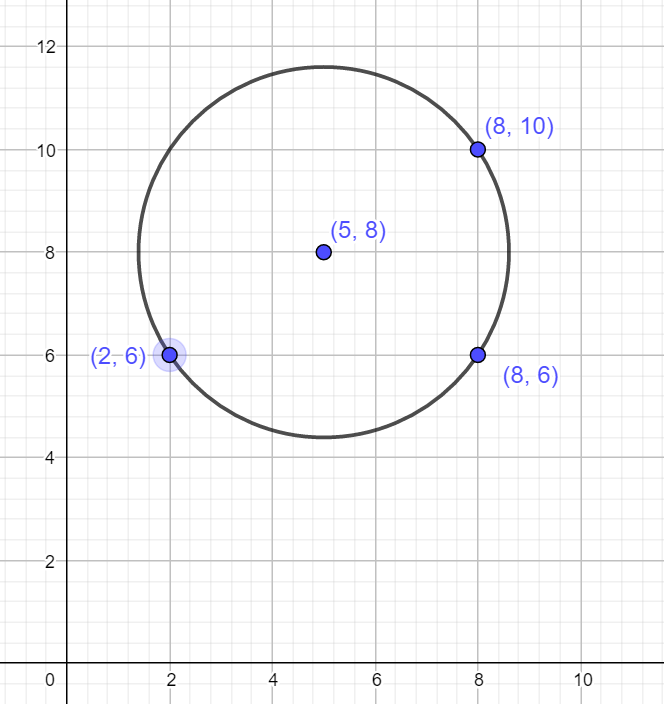Thanks Geno, that is a excellent method.
It always pays to do a quick sketch and then facts like this are more likely to be seen.
Here is the super long methods.
I'd have let the centre of the circle be (x,y)
Then found the distances and said they had to be equal.
\(r^2=(x-6)^2+(y-2)^2\qquad(1)\\ r^2=(x-8)^2+(y-6)^2\qquad (2)\\ r^2=(x-8)^2+(y-10)^2 \qquad (3)\\~\\ (3)-(2)\\ 0=(y-6)^2-(y-10)^2\\ 0=y^2-12y+36-(y^2-20y+100)\\ 0=y^2-12y+36-y^2+20y-100\\ 0=8y-64\\ 0=y-8\\ y=8\\~\\ sub\;\; in\\ r^2=(x-6)^2+(6)^2\qquad(1b)\\ r^2=(x-8)^2+(2)^2\qquad (2b)\\ subtract\\ 0=(x-6)^2+36-(x-8)^2-4\\ 0=(x^2-12x+36)+36-(x^2-16x+64)-4\\ 0=-12x+36+36+16x-64-4\\ 0=4x+4\\ x=-1 \)
\(r^2=(x-2)^2+(y-6)^2\qquad(1)\\ r^2=(x-8)^2+(y-6)^2\qquad (2)\\ r^2=(x-8)^2+(y-10)^2 \qquad (3)\\~\\ (3)-(2)\\ 0=(y-6)^2-(y-10)^2\\ 0=y^2-12y+36-(y^2-20y+100)\\ 0=y^2-12y+36-y^2+20y-100\\ 0=8y-64\\ 0=y-8\\ y=8\\~\\ sub\;\; in\\ r^2=(x-2)^2+(0)^2\qquad(1b)\\ r^2=(x-8)^2+(0)^2\qquad (2b)\\ subtract\\ 0=(x-2)^2-(x-8)^2\\ 0=(x^2-4x+4)-(x^2-16x+64)\\ 0=-4x+4+16x-64\\ 0=12x-60\\ x=5\\~\\ \text{So the centre is (5,8)} \)

Coding:
r^2=(x-2)^2+(y-6)^2\qquad(1)\\
r^2=(x-8)^2+(y-6)^2\qquad (2)\\
r^2=(x-8)^2+(y-10)^2 \qquad (3)\\~\\
(3)-(2)\\
0=(y-6)^2-(y-10)^2\\
0=y^2-12y+36-(y^2-20y+100)\\
0=y^2-12y+36-y^2+20y-100\\
0=8y-64\\
0=y-8\\
y=8\\~\\
sub\;\; in\\
r^2=(x-2)^2+(0)^2\qquad(1b)\\
r^2=(x-8)^2+(0)^2\qquad (2b)\\
subtract\\
0=(x-2)^2-(x-8)^2\\
0=(x^2-4x+4)-(x^2-16x+64)\\
0=-4x+4+16x-64\\
0=12x-60\\
x=5\\~\\
\text{So the centre is (5,8)}